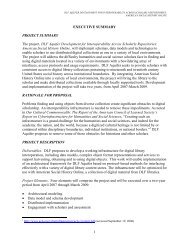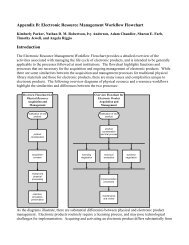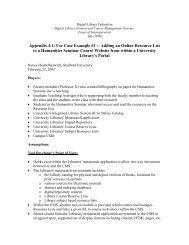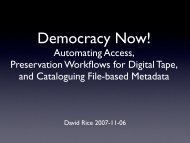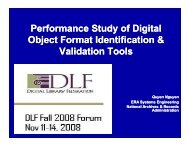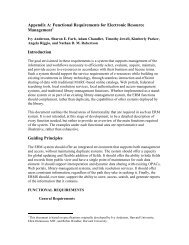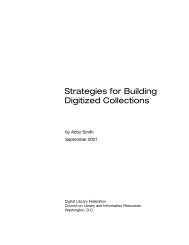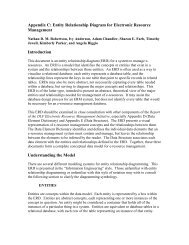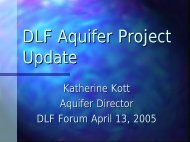IT'S ONLY A MOVING IMAGE Archives, Access and the Social Contract ...
IT'S ONLY A MOVING IMAGE Archives, Access and the Social Contract ...
IT'S ONLY A MOVING IMAGE Archives, Access and the Social Contract ...
You also want an ePaper? Increase the reach of your titles
YUMPU automatically turns print PDFs into web optimized ePapers that Google loves.
How can we begin to collect <strong>and</strong> expose moving image materials without doing <strong>the</strong> history ofmoving image archiving all over again? And how can we take up <strong>the</strong> challenges <strong>the</strong>se materialspose — which will face most of us if <strong>the</strong>y haven’t already — <strong>and</strong> embrace <strong>the</strong>m, as a way to movetowards closer <strong>and</strong> more productive relationships with our users?6
So I’m going to talk for a bit about <strong>the</strong> mysteries of what I call "moving image exceptionalism," using <strong>the</strong>idea as a vehicle to try to underst<strong>and</strong> why moving images persist as an isl<strong>and</strong> of inaccessibility.7And <strong>the</strong>n I’d like to try to use <strong>the</strong> example of moving images as a shortcut to exploring some access issues<strong>and</strong> talking about some possible futures.
A BIT OF(FILM) HISTORYFirst —8
Almost from <strong>the</strong> beginning of cinema, pioneers proposed establishing moving image archives. But film posed specialstorage problems <strong>and</strong> <strong>the</strong>ir proposals were often seen as extreme. It would take until <strong>the</strong> 1930s for <strong>the</strong> will to saveendangered motion pictures to coalesce into an organizational effort. Pioneer archivists at MoMA, BFI, Cinema<strong>the</strong>queFrancaise organized in 1935. The Library of Congress started selecting films from copyright deposits for retention in <strong>the</strong>irpermanent collections in 1942. Over many years, <strong>the</strong> National <strong>Archives</strong> received films from many Federal agencies,notably Agriculture <strong>and</strong> <strong>the</strong> military.9
Early film archives took on a complex basket of burdens. They were growing up in a culture that hadn’t yet accepted<strong>the</strong>m. This meant that many acquisitions were sourced under unconventional circumstances <strong>and</strong> archives felt vulnerableto exposure <strong>and</strong> sanctions. Political censorship <strong>and</strong> ideological cleansing, copyright issues <strong>and</strong> <strong>the</strong> conspiratorialpsychology of private film collectors all made <strong>the</strong>ir work risky. Holdings, catalogs <strong>and</strong> metadata were often consideredprivileged information. This situation continues to characterize many archives, especially those located where freeexpression may be problematic.10
MoMA, <strong>the</strong> BFI, <strong>the</strong> Cinema<strong>the</strong>que Francaise <strong>and</strong> <strong>the</strong> Reichfilmarchiv toge<strong>the</strong>r founded FIAF (Intl Federation of Film<strong>Archives</strong>) in 1938. This codified a tradition of international cooperation, supplying one ano<strong>the</strong>r with elements on filmsthat were to be preserved, lending prints for internal screenings, <strong>and</strong> assisting one ano<strong>the</strong>r to safeguard material that wastoo hot to h<strong>and</strong>le openly. This continued even during World War II, when archivists from belligerent countriescooperated to hide sensitive materials or save <strong>the</strong>m from destruction.11
We must sometimes applaud guardianship at <strong>the</strong> same time we criticize its persistence. This might be one way to thinkabout <strong>the</strong> legacy culture of film archives whose model remained dominant until very recently. The earliest film archivistswere cinephiles who dared to collect physically endangered works or films of uncertain provenance, ignored culturaldisdain for <strong>the</strong> populist medium, courted severe punishment for saving <strong>and</strong> hiding politically discredited films, floutedcopyright laws whose interpretation was even more Draconian <strong>the</strong>n as now, <strong>and</strong>, last but not least, risked nitrate fires.They loved cinema <strong>and</strong> achieved much despite <strong>the</strong>ir cautious culture <strong>and</strong> <strong>the</strong> limitations placed on <strong>the</strong>ir activities.12
In such a problematic context, collecting took priority over preservation <strong>and</strong> preservation over access. <strong>Access</strong> wasreserved for trusted parties under controlled conditions. Aside from loans to o<strong>the</strong>r FIAF members or carefully-controlled<strong>the</strong>atrical screenings, access was granted only to qualified parties, always in house, restricted to materials printed frompreservation intermediates, <strong>and</strong> limited by countless conditions. There were reasons for all of <strong>the</strong>se limitations, no matterhow anachronistic <strong>the</strong>y may seem to newcomers in <strong>the</strong> field, <strong>and</strong> that is why many of <strong>the</strong> old rules continue to survive.13
Pregnant turtle radiograph: Megan Shaw Prelinger14In <strong>the</strong> past 25 years, hundreds of new moving image repositories have come into being. The field ismuch more pluralistic, <strong>and</strong> collections are incredibly diverse. Archival training programs arepumping out graduates. The Association of Moving Image Archivists has over 700 members. TheNFPF has preserved 1100 orphaned films. But <strong>the</strong>re are many missing pieces. We lack a sense ofwhere we fit into <strong>the</strong> culture <strong>and</strong> <strong>the</strong> economy. Our missions <strong>and</strong> goals are atomized ra<strong>the</strong>r thanaggregated. We are very slowly making peace with technology, but more often it just threatens us.We are taking only halting steps towards opening up our collections for access. And we are terriblyunderfunded. I’m guessing you could run a hundred film archives for what it takes to run amoderate-sized research library. A cynic might say that we’re ripe for predation.
So, a paren<strong>the</strong>sis. Over a hundred years of film, perhaps 600,000 US productions. We produced on amass level, but we collected as an artisanal practice. Easily 1/3 to 1/2 of films were irretrievably lost.What survived was often due to oversights or lucky accidents. And we started very late. Even now LC isscrambling to collect a critical mass of industrial, advertising <strong>and</strong> educational films. Almost everyoneagreed that films were inherently ephemeral <strong>and</strong> should stay that way — that films were lower-levelcultural documents. This is now done <strong>and</strong> gone, but we’re treating TV <strong>and</strong> online video <strong>the</strong> same way.When one points this out, we throw our h<strong>and</strong>s up <strong>and</strong> say, “There’s too much! What else can we do?” Withfew exceptions, we still approach mass media one show at a time. On a positive note, archives arestarting to collect Web pages while <strong>the</strong>y’re young <strong>and</strong> fresh.15
Canonical moving image archives users• o<strong>the</strong>r accredited archives• copyright owners & distributors• approved exhibition venues (museums,cinema<strong>the</strong>ques, some rep <strong>the</strong>aters)• cinema studies scholars & <strong>the</strong>ir kin• film/video producers & researchers(often kept at arm’s length)Here are <strong>the</strong> classical users of moving image archives.Past <strong>and</strong> present, each one of <strong>the</strong>se groups might be described as wholesale users: <strong>the</strong>y’re typically intermediaries thatproduce or distribute works that will <strong>the</strong>n find <strong>the</strong>ir way to specific groups of <strong>the</strong> public. Wholesale ra<strong>the</strong>r than retail. Thepublic itself isn’t welcome, <strong>and</strong> for a number of very good reasons usually can't be made terribly welcome, on <strong>the</strong>premises of most moving image archives.But even today, some moving image archivists would arch <strong>the</strong>ir eyebrows in surprise if you dared to suggest that this listmight be incomplete.16
“wholesale”to“retail”17The list is, in fact, outdated. The big development is that recent years archives have gone retail. Their erstwhile patronshave been augmented by members of <strong>the</strong> public, independent scholars <strong>and</strong> citizen scientists, an aggressive army ofcommercial clients, a growing cadre of "archival fans," <strong>and</strong> of course genealogists (arguably <strong>the</strong> largest group of textualarchives users). This won’t be a surprise to many of you.When <strong>and</strong> how did this happen?
movement from institutional to individual productionUntil a few years ago, archival access was a downstream process. People consumed derivative works —programs,books, exhibits using archival material — made by <strong>the</strong> “wholesale” users I just mentioned, who were usually based inproduction companies or institutions. But now individuals are starting to make <strong>the</strong>ir own archivally-based works, whichstretch across <strong>the</strong> continuum from sublime to trivial. Millions also engage in some form of “self-archiving” of <strong>the</strong>ir ownwork using a variety of friendly web services. And of course <strong>the</strong>y upload not just <strong>the</strong>ir own work.18
entitlement19In fact, as many archivists know, people are beginning to feel quite a sense of entitlement relative to archival collections.They sometimes make dem<strong>and</strong>s that are difficult to address. On <strong>the</strong> positive side, we’ve ourselves discovered that peopledevelop passionate interest in unedited archival footage; <strong>the</strong>y don’t lament <strong>the</strong> absence of editing, narration <strong>and</strong>background music, <strong>the</strong>y want to see <strong>the</strong> original document! And many people remix, reedit <strong>and</strong> recontextualize <strong>the</strong>collections. Since we gave almost 2,000 of our own films to <strong>the</strong> Internet Archive for unrestricted access <strong>and</strong> reuse, we’veseen around 8 million downloads in 7 years, <strong>and</strong> I’ll make a wild estimate that over ten thous<strong>and</strong> derivative works havebeen made from <strong>the</strong>m.
There’s even an archival fan community that lives on <strong>the</strong> net. A kind of "archives cult" has sprouted <strong>and</strong> <strong>the</strong>re’s adiscernible fan culture, traceable back to peoples’ personal investment with archival materials. Here’s <strong>the</strong> MySpace pagefor a Brazilian b<strong>and</strong> known as "Prelinger <strong>Archives</strong> Orchestra," fronted by a guy named Eduardo Ramos, that played itsfirst gig in 2003.It’s easy to dismiss fan culture as a lesser kind of engagement, but it often leads academic interest <strong>and</strong> has great potentialto draw attention <strong>and</strong> funding to an area of study. The vector from online discussion forums to peer review is perhapsshorter than one would think. I’d argue that emergent fields <strong>and</strong> disciplines need to nurture a fan infrastructure toincrease reach <strong>and</strong> viability. Look, for example, at LibraryThing.20
1960s: Oldskool TV docs: war, disasters, movie stars! “Official” materials: newsreels, gov’t films1970s: Key compilation features:(Gizmo, Bro<strong>the</strong>r Can You Spare A Dime) Nostalgia craze begins, heavy “retro” marketing1980s: Media business opens up, many new distro outletsCable, homevideo need cheap airtime<strong>Archives</strong> flower: Atomic Cafe, music videos, countlesscommercials, corporate videos, cable docs,MTV on-air promo, etc.Ephemeral films resurfaceAUDIO AND VIDEO SAMPLING1990s: Remixing infects art world2000s: Remixing moves from art to amateurism22Starting in <strong>the</strong> 1970s, media began to look quite different. We see <strong>the</strong> emergence of hi<strong>the</strong>rto unseen archival material inTV <strong>and</strong> documentaries — industrial, advertising, amateur, educational, purely evidentiary films <strong>and</strong> similar visualdocuments. These more populist genres edged out more "official" materials, such as newsreels <strong>and</strong> government films,<strong>and</strong> began to increase popular consciousness of archives. “Where did all this stuff come from?” people asked. AtomicCafé, made in 1982, was an important waypoint. The efflorescence of media distribution outlets acted like a magnet topull images out of archives. I’d also point in passing to <strong>the</strong> emergence of sampling <strong>and</strong> remix culture, which I think has anon-trivial connection to archives.
not just “movies”It may be obvious to many of you, but moving image archives don't just collect <strong>the</strong>atrical “movies.” Much more film isunedited than edited; much more videotape exists than film; <strong>and</strong> much more digital video than ei<strong>the</strong>r film or tape.23
Fuzzy statistics• At least 4 times as many ephemeral (educational,industrial, advertising) films as features were made.Perhaps < 50-60% exist, somewhere• For each release print = at least 1 to 8 rolls of masteror preprint elements, plus outtakes, if <strong>the</strong>y exist• No one knows how much amateur film still exists (tosay nothing of amateur video)• Millions of ephemeral videos now produced each year• Estimated videos online ≈ 120 million• Estimated online at YouTube ≈ 24 million• The most numerous “genres” are <strong>the</strong> least studiedIt’s easy to pile up interesting statistics like this, but <strong>the</strong>y tend to have little more than a silencing effect.That said, we can see that moving images of evidentiary value far outnumber those that were producedintentionally to entertain. And I’m not even talking about surveillance video.One thing worth pointing out is that no one knows in <strong>the</strong> aggregate how much of which formats are held inspecial collections <strong>and</strong> archives, <strong>and</strong> no moving image archivist knows how much is out in <strong>the</strong> worldwaiting to be formally collected. We’ve come a long way from <strong>the</strong> relatively bounded universe of, say, EarlyEnglish Books Online.24
Master H<strong>and</strong>s (Jam H<strong>and</strong>y Organization for Chevrolet Motor Company, 1936)25Today, TV productions, public exhibitions, advertising, <strong>and</strong> ambient video (images just playing on <strong>the</strong> wall, whichI would bet will be <strong>the</strong> primary archival market of <strong>the</strong> future) all rely heavily on ephemeral, non-official, non-Hollywood material. Personal <strong>and</strong> local experience has triumphed over more official narratives, <strong>and</strong>commonplace ideas of what history is <strong>and</strong> what it might be have broadened. Again, this has tended to encouragegrassroots interest in historical material.
lyngsat.com, accessed 3 Nov 2007And I also haven’t mentioned TV. The Television Archive, a sister project of <strong>the</strong> Internet Archive,has collected about a million hours of broadcast TV since April 2001. It’s all sitting on hard disk,prevented by law from even educational distribution. There are many o<strong>the</strong>r similar collections.26The slide shows slivers from <strong>the</strong> list of Iraqi <strong>and</strong> US satellite services.
Lost generations• Growing body of unprocessed moving images:(2000 ARL survey indicated 35% video, 37%audio remain unprocessed; film not mentioned)• Most moving image archives haven’t beensystematically surveyed• Born-digital moving image materials that firstappear online: we can only guess — not beingwidely collectedWe’re going to have to survey <strong>the</strong> field, even as we admit that we cannot <strong>and</strong> should not collect it all. Filmhas lived in special collections for years, much of it unprocessed <strong>and</strong> unseen. Video is now flooding in, <strong>and</strong>would be coming in even faster if we were able to collect all we should. We can’t.27
egionalism <strong>and</strong> <strong>the</strong> lure of <strong>the</strong> localBut o<strong>the</strong>rs are out <strong>the</strong>re collecting, quite often outside major research institutions. Regional <strong>and</strong> specializedarchives are incubating innovative practices, many of <strong>the</strong>m community-based, like Home Movie Day <strong>and</strong> urbanhome movie recovery <strong>and</strong> revival projects. New ideas are originating at <strong>the</strong> periphery <strong>and</strong> many of <strong>the</strong>m willinfuse <strong>the</strong> center.28
Garden for <strong>the</strong> Environment,San FranciscoThere are hundreds of new public moving image collections in <strong>the</strong> US alone, <strong>and</strong> <strong>the</strong>ir proliferation testifies tointerest in archives. As soon as it gets darker, <strong>the</strong>se people will watch an archival film about gardening, <strong>and</strong><strong>the</strong>re’ll be loud BOOS when Pop starts spraying <strong>the</strong> vegetables.29
30At <strong>the</strong> same time, we are seeing a growing disconnect between archives <strong>and</strong> users. The emerging user communities (oftenyounger people) don’t see why <strong>the</strong>ir ability to access collections should be limited by institutional priorities, low budgetsor online unavailability. They come from a world that increasingly works on Internet time, where knowledge is rapidlybeing made freely available in digital form at little or no apparent cost. To <strong>the</strong>se users, whose numbers are growing, <strong>the</strong>reis little reason why archival access should be a sticky door. Do we educate <strong>the</strong>m about realities? Do we try to make iteasier for <strong>the</strong>m to get material? Or do we ignore <strong>the</strong>m? NO MATTER WHAT PATH WE CHOOSE, ACCESS STARTSTO GET COMPLICATED.
valuebegetsenclosure31With <strong>the</strong> emergence of new distribution media <strong>and</strong> <strong>the</strong> practical elaboration of Long Tail business models, <strong>the</strong> perceivedvalue of archival holdings is increasing. <strong>Archives</strong> are now strategic repositories, <strong>and</strong> archivists have become de factogatekeepers to valuable collections. The prototypical narrative of this change is <strong>the</strong> transition of <strong>the</strong> Hollywood studiolibraries from quiet bunkers in neglected corners of <strong>the</strong> lot into secure, temperature- <strong>and</strong> humidity-controlled vaultbuildings filled with "media assets" whose book value figures prominently on <strong>the</strong> corporate balance sheet. Greaterperceived value causes fences to rise from <strong>the</strong> ground <strong>and</strong> walls to be built.
In two years, YouTube built an easy-to-access onlinecollection (≈24 million videos) that I'd argue hasbecome <strong>the</strong> world's default media archives. Everythinganyone does to bring moving image archives online willnow be measured against YouTube's ambiguous legacy. Itoffers a sense of completeness: a massive collection ofold <strong>and</strong> new video, from video of Malcolm X's completespeeches to clips of <strong>the</strong> moose I saw w<strong>and</strong>ering inpeople's front yards in Anchorage. It sticks to previewmode, presenting visually degraded Flash video, <strong>and</strong> it’sbeing sued right <strong>and</strong> left, but most rightsholders willrightfully regard what it does as promotion. Best of all,it invites users to upload almost anything, annotate withrelative freedom <strong>and</strong> network with one ano<strong>the</strong>r.And <strong>the</strong>re’s <strong>the</strong> possibility that archives have in fact lost altoge<strong>the</strong>r to commercial services. Media archives have facedsuch opposition internally <strong>and</strong> from copyright holders that <strong>the</strong>y tend to take baby steps towards exp<strong>and</strong>ing online access.Now that YouTube has raised public expectations (while lowering quality expectations), it’s hard to see how anyinstitution can equal <strong>the</strong>m. Not to overdramatize, but I think archives lost this one. --- (Of course, YouTube is not anarchive in any sense of <strong>the</strong> word - it doesn't do preservation, lacks a guarantee of persistence, <strong>and</strong> lives to be a commercialservice)32
moving image exceptionalismBut let’s put aside worries about <strong>the</strong> future <strong>and</strong> roll back <strong>the</strong> clock...33So what do I mean by moving image exceptionalism? Here are a few quick attributes.
Moving image exceptionalism• format(s) <strong>and</strong> fragility make people uneasyFORMATS AND FRAGILITY:--> Hundreds of formats, each with special characteristics <strong>and</strong> a distinct workflow;h<strong>and</strong>ling equipment fast becoming obsolete, many unpreserved works exist in a single copynitrate, vinegar syndrome -- special storage neededdisks are very young, flash memory even younger--> round, heavy, smelly objects on rectangular shelves34
Moving image exceptionalism• format(s) <strong>and</strong> fragility make people uneasy• expensive to touch<strong>MOVING</strong> <strong>IMAGE</strong>S ARE EXPENSIVE TO TOUCH:--> technology is born <strong>and</strong> dies quickly--> cost of reformattingmay need specially trained staffspecialized vendors are expensive--> often <strong>the</strong> “LOGICAL” decision is to let it sit on <strong>the</strong> shelf35
Moving image exceptionalism• format(s) <strong>and</strong> fragility make people uneasy• expensive to touch• access has historically been contingent on processing, cataloging &preservationHere’s where moving images meet Greene/Meissner. <strong>Access</strong> to archival moving images has traditionallybeen coupled with preservation. In order to make collections accessible to <strong>the</strong> widest possible number ofusers, we must now consider digitization that primarily serves access. Digitization exp<strong>and</strong>s access <strong>and</strong>confers o<strong>the</strong>r benefits on collections, including especially visibility, which often drives preservation.36
Unbundling access from preservation,cataloging & description• Digitization confers visibility on collections, which canhelp drive preservation (what’s this?)• This isn’t our first massive paradigm shift on preservation(film/film copying to cold storage)• Expose unpreserved <strong>and</strong> uncataloged collections online• Users as partners in description & contextualization• Ask forgiveness ra<strong>the</strong>r than permission• Put reading copies on open shelves• Default to access ra<strong>the</strong>r than enclosure (<strong>and</strong> ritual)• Honestly identify <strong>and</strong> expose unencumbered (or mostlyunencumbered)materialsMuch of this has been discussed, <strong>and</strong> much is being done in <strong>the</strong> textual <strong>and</strong> visual materials world. It’ssummed up very well in “Shifting Gears,” a new paper by Ricky Erway <strong>and</strong> Jennifer Schaffner. Butinterestingly enough, <strong>the</strong>se ideas are deeply controversial in <strong>the</strong> moving image archives world, <strong>and</strong> <strong>the</strong>y’renot being actualized. At least for me, this is a unsettling instance of exceptionalism.--We don’t know what preservation means any more.--<strong>Archives</strong> hold many materials that aren’t encumbered by copyright or donor restrictions, but it oftenisn’t in <strong>the</strong>ir interest to expose <strong>the</strong>m because of staff <strong>and</strong> financial constraints.37
Moving image exceptionalism• format(s) <strong>and</strong> fragility make people uneasy• expensive to touch• access has historically been contingent on processing, cataloging &preservation• “seething bundle of rights” Some films are complex bundles of rights. Although probably no amateur films post-1923 are in public domain, thatdoesn’t reduce <strong>the</strong> vast traffic in home movies <strong>and</strong> <strong>the</strong>ir exposure in <strong>the</strong> public sphere -- <strong>the</strong>y sell for big $$$ on eBay. many rightsholders are quite often unknown or unlocatable -- <strong>the</strong> orphan works problem AND IT NEEDS TO BE SAID THAT WE HAVE HUGE PUBLIC DOMAIN IN THE U.S., AND ARCHIVESCONTROL LOTS OF PD <strong>MOVING</strong> <strong>IMAGE</strong>S. For a number of reasons, this seems to be soft-pedaled.38
Moving image exceptionalism• format(s) <strong>and</strong> fragility make people uneasy• expensive to touch• access has historically been contingent on processing, cataloging &preservation• “seething bundle of rights”• powerful rightsholders & donors engender excessive deference We are excessively deferential to claims we haven’t received from rightsholders we often can’t identify but who wouldn’t be scared of studios, TV networks, estates of authors <strong>and</strong> celebrities? we hear about crackdowns on “pirates” <strong>and</strong> imagine we are next fear of offending, fear of missteps; fear of fear itself39
Moving image exceptionalism• format(s) <strong>and</strong> fragility make people uneasy• expensive to touch• access has historically been contingent on processing, cataloging &preservation• “seething bundle of rights”• powerful rightsholders & donors engender excessive deference• “Hollywood models” (copyright maximalism, DRM) infect library <strong>and</strong>archives world<strong>Archives</strong> <strong>and</strong> libraries are unintended receivers of moving images -- no one models protocols for us.Into this vacuum, corporate models creep. We embrace <strong>the</strong>m as substitutes for user-centered access models that some call“impractical” or “unthinkable.”Many forms of moving images, like home movies <strong>and</strong> orphan works, have no functional model for addressing <strong>and</strong>h<strong>and</strong>ling rights.Then <strong>the</strong>re’s DRM, electronic locks that restrict use, including fair use, of cultural materials for cultural purposes.We worry about “losing control over our collections.” This sometimes leads archives <strong>and</strong> collections to contemplateexogenous security solutions <strong>and</strong> controls, some of <strong>the</strong>m made in Hollywood. Isn’t that losing control?40
Moving image exceptionalism• format(s) <strong>and</strong> fragility make people uneasy• expensive to touch• access has historically been contingent on processing, cataloging &preservation• “seething bundle of rights”• powerful rightsholders & donors engender excessive deference• “Hollywood models” (copyright maximalism, DRM) infect library <strong>and</strong>archives world• flux of culture industry business models fascinates <strong>and</strong> stupefies manynoncommercialists41Entertainment industry business models are in flux <strong>and</strong> will change quickly. LET’S NOT ETERNALIZE THE PRESENT.There will be more Googles. In contrast, some of us have been around for hundreds of years.These are not our models. Can we let <strong>the</strong>m blow over us?[We exist to support research <strong>and</strong> education.]
Moving image exceptionalism• format(s) <strong>and</strong> fragility make people uneasy• expensive to touch• access has historically been contingent on processing, cataloging &preservation• “seething bundle of rights”• powerful rightsholders & donors engender excessive deference• “Hollywood models” (copyright maximalism, DRM) infect library <strong>and</strong>archives world• flux of culture industry business models fascinates <strong>and</strong> stupefies manynoncommercialists• contention over spectrum of access (<strong>the</strong>atricalists, surrogators, keepers of<strong>the</strong> family jewels)Among archivists, <strong>and</strong> especially moving image archivists, <strong>the</strong>re are many differences of opinion about whe<strong>the</strong>r weshould move beyond legacy forms of access <strong>and</strong>, if so, how.Some wish to preserve <strong>the</strong> <strong>the</strong>atrical experience as it’s been experienced for a century.O<strong>the</strong>rs accept <strong>the</strong> existence of surrogates, more or less (<strong>the</strong>re’s a spectrum from carefully crafted DVDs to "pictures ofmovies" – eg online derivatives)O<strong>the</strong>rs (such as in some museums) hope to keep a model of scarcity (as Lessig puts it) alive.42
Moving image exceptionalism• format(s) <strong>and</strong> fragility make people uneasy• expensive to touch• access has historically been contingent on processing, cataloging &preservation• “seething bundle of rights”• powerful rightsholders & donors engender excessive deference• “Hollywood models” (copyright maximalism, DRM) infect library <strong>and</strong>archives world• flux of culture industry business models fascinates <strong>and</strong> stupefies manynoncommercialists• contention over spectrum of access (<strong>the</strong>atricalists, surrogators, keepers of<strong>the</strong> family jewels)• seen by many as special interest, not primary evidenceThis could be a lecture in itself.for years scholars preferred textual records to visual or moving images<strong>the</strong> perception that moving image records are something short of "primary evidence" persists-- Pan<strong>the</strong>r New Haven storythis has started to change, but not fast enough43
Moving image exceptionalism• format(s) <strong>and</strong> fragility make people uneasy• expensive to touch• access has historically been contingent on processing, cataloging &preservation• “seething bundle of rights”• powerful rightsholders & donors engender excessive deference• “Hollywood models” (copyright maximalism, DRM) infect library <strong>and</strong>archives world• flux of culture industry business models fascinates <strong>and</strong> stupefies manynoncommercialists• contention over spectrum of access (<strong>the</strong>atricalists, surrogators, keepers of<strong>the</strong> family jewels)• seen by many as special interest, not primary evidence• moving image archivists live <strong>and</strong> work in bubblesThe moving image archives field developed in isolation. Until a few years ago, <strong>the</strong>re were notraining programs in <strong>the</strong> US. now <strong>the</strong>re are several that are pumping out trained archivists -- Theseprograms have opened up discourse around important issues <strong>and</strong> helped create interest inneglected areas, but many older archivists have not been exposed to newer ideas. And, perhaps it’sdue to cinephilia, but moving image people tend to look inward ra<strong>the</strong>r than out.44
Lessons of moving-image exceptionalism:how not to repeat <strong>the</strong> past (I)• Get a fresh start with born-digital materials• Don’t hobble digitized materials withnewborn restrictions• Don't let corporate models infect (or inflect)libraries <strong>and</strong> archives•We aren’t backup repositories for mediacompanies, publishers or search enginesWe need to make a fresh start with born-digital <strong>and</strong> get it right this time.Lead us not into temptation. Let’s default to openness ra<strong>the</strong>r than enclosure. Don’t let <strong>the</strong> precautionaryprinciple prevail over <strong>the</strong> propagation of culture.Our corporate partners may be interested in working with our holdings (which is good), but that doesn’tmean we have to adopt or internalize <strong>the</strong>ir business models, which will evolve much more quickly thanours, quite possibly into irrelevancy.We can do partnerships without losing our autonomy <strong>and</strong> without undervaluing our collections.45
Lessons of moving-image exceptionalism:how not to repeat <strong>the</strong> past (II)• How can we be goals-driven <strong>and</strong> userfocusedwhile saving collections?• Where isolation is endemic <strong>and</strong> budgetsprecarious, users can be powerful allies•Workflows are not sacred. The Greene-Meissner message hasn’t got through tomoving image collections• The legacy of enclosure is long-lasting•Cosmopolitanism & hybridization serve ourinterests: libraries ←→ archivesGoals-driven <strong>and</strong> user-focused. This has been hard to achieve in <strong>the</strong> moving image archives world. We have savedmany collections. Now it’s time to achieve greater ambitions.Isolation. Users are a powerful <strong>and</strong> little-used constituency who can link us with <strong>the</strong> world <strong>and</strong> help us find support forour activities.Workflows. We need to privilege access; we have many private rituals that tend to defer access, sometimes indefinitely.Enclosure. What sometimes seems to be a no-brainer decision to “protect” materials may haunt us <strong>and</strong> future users for avery long time.Hybridization. ”Outside lies magic,” as <strong>the</strong> geographer John Stilgoe says. <strong>Archives</strong> have much to learn from libraries;both have much to learn from geeks; innovation happens on <strong>the</strong> periphery. Our own discourses <strong>and</strong> practices constantlyneed a refresh.46
I often wonder why libraries <strong>and</strong> archives mirror so many of <strong>the</strong> constraints <strong>and</strong> hierarchies of <strong>the</strong> worldaround us, when it would be just as reasonable for <strong>the</strong> WORLD TO LOOK TO US FIRST for leadership aroundissues of access to culture <strong>and</strong> information. It seems to me that we could do more than just set anexample — we could be a FORCE FOR CLARITY AND MINDFULNESS when it comes to deciding how culture ismade visible <strong>and</strong> distributed. I’m not just talking about <strong>the</strong> realms of research <strong>and</strong> education, butthroughout society. This is critical as technology evolves, <strong>and</strong> as culture <strong>and</strong> business become ever moreintertwined.So, a few last thoughts.47
<strong>the</strong> implicit social contractwith our users (<strong>and</strong> society)is defined above all by accessRegardless of who pays <strong>the</strong> bills, libraries <strong>and</strong> archives depend on social <strong>and</strong> cultural consensus for legitimacy <strong>and</strong> <strong>the</strong>support we need to survive. Whe<strong>the</strong>r spoken or unspoken, this consensus rests upon <strong>the</strong> perception that our institutionsfulfill a valuable cultural role. I believe this perception will be streng<strong>the</strong>ned or weakened largely in relation to <strong>the</strong>character <strong>and</strong> depth of access we provide.Preservation may be our raison d’etre, but access is our connection with <strong>the</strong> world.48
<strong>Access</strong> is a spectrum; openness a practice[LEAST OPEN]content archived <strong>and</strong> unavailablecontent available for in-house research access with permissioncontent available for in-house research access without permissioncontent circulates within controlled world (e.g., print loans)content licensable by special arrangementlow-resolution streaming video copies available onlinehigh-resolution streaming video copies available onlinecontent not interoperable with content in o<strong>the</strong>r collectionsquotation allowed without reproductionquotation allowed with reproduction (e.g., frame grabs)reference-quality, time-coded, Elmo, defaced study copies furnishedbroadcast-quality or projectable copies furnisheduser-controlled copying in-houselow-resolution downloadable copies available onlinehigh-resolution downloadable copies available onlinecontent licensable by simple arrangementcontent interoperable with o<strong>the</strong>r collectionscontent freely available for reuse with restrictions (e.g., noncommercial use)content freely available for sharing onlinecontent freely indexable, crawlable, navigable by noncommercial web servicescontent freely indexable, crawlable, navigable by anyonecontent freely available for any reuse without restrictioncomponent parts of works (e.g., shots, segments, audio tracks, edit lists) available freely online without restriction[MOST OPEN]But we need to model access, especially open access. Don Waters is right to criticize “faith-based assumptions thatonly beneficial consequences will follow from providing open access.” On <strong>the</strong> o<strong>the</strong>r h<strong>and</strong>, many of us have putmaterials online out of an inarticulate faith that mass discovery might enable authorship, scholarship <strong>and</strong> researchamong new groups <strong>and</strong> in new ways, <strong>and</strong> we are seeing exciting consequences. This has certainly been my ownstory. How can we anticipate user dem<strong>and</strong>, ra<strong>the</strong>r than react to it? What’s an optimal <strong>and</strong> dynamic model ofaccess that evolves over time? Ano<strong>the</strong>r way of asking this: How can we uphold a dynamic social contract with ourusers? These are <strong>the</strong> kinds of strategic questions that we need to pursue.49
"Given material abundance,scarcity must be a function of boundaries."— Lewis Hyde, The Gift: Imagination <strong>and</strong> <strong>the</strong> Erotic Life of Property, 1979-8350The same technologies that potentially enable access on a level that we’ve never seen also enable an unprecedentedlevel of enclosure. All of us will have to decide which tools we want to use <strong>and</strong> which we’d ra<strong>the</strong>r lay idle. LarryLessig talks about <strong>the</strong> “model of plenty” supplanting <strong>the</strong> “model of scarcity.” Plenty <strong>and</strong> scarcity aren’tcharacteristics that we discover about collections, but attributes with which we choose to clo<strong>the</strong> <strong>the</strong>m.
I am convinced that openness, <strong>and</strong> I use <strong>the</strong> word knowing that it’s a young word <strong>and</strong> still imprecise, willbe critical to our futures. Openness will enable us to survive as primary, trusted repositories in a confusedcultural <strong>and</strong> media l<strong>and</strong>scape. We want people to knock on our doors. If <strong>the</strong>y don't find what <strong>the</strong>y’reseeking in official, trusted repositories, <strong>the</strong>y'll grow to depend on <strong>the</strong> YouTubes of <strong>the</strong> world. Copyrightkinks (<strong>and</strong>, perhaps more significant, access constraints) already force countless film studies professorsinto <strong>the</strong> ne<strong>the</strong>rworld of bootlegs. It would be better to find ways to make people come to us.51
52Let’s take a leaf from environmentalist practice <strong>and</strong> think about how our activities affect our CORE MISSIONS. How doour projects, our digitization initiatives <strong>and</strong> partnerships affect PRESERVATION AND ACCESS? What if we were todraft regular preservation <strong>and</strong> access impact statements, akin to environmental impact statements? How does ScanningProject A affect access to our collections? What impact will Video Digitizing Project B have upon <strong>the</strong> preservation of <strong>the</strong>bits? Impact statements could help us underst<strong>and</strong> which individual projects best move us forward, <strong>and</strong> ultimately todevelop a shared sense of value about projects that have often been difficult to assess.
Unlike many of my copyfighting friends, I believe that <strong>the</strong> extreme positions of today’s copyright wars willappear quaint in a few years. But it will take real work to get to that point. Many conflicts over access to<strong>and</strong> control over culture reflect generational divides. And <strong>the</strong>re are real generational inequities in <strong>the</strong>current copyright system. I’m a boomer, <strong>and</strong> much of my cultural heritage has already risen into <strong>the</strong>public domain. This isn’t <strong>the</strong> case for so-called “Genxers” <strong>and</strong> Millennials, who have much less latitude totell <strong>the</strong>ir own histories cheaply. This, plus <strong>the</strong> unsettled orphan works situation, may encourage change,which would be very much in all of our interest.53
Photo: Jose Maria “Chema” Barredo54In recent years cultural materials have developed a singular tendency to escape enclosure, <strong>and</strong> I tendto think many limits on access will loosen in time. The present system of copyright <strong>and</strong> contractualcontrols is evolving because it needs to; it doesn’t even work well for its prime beneficiaries.Culture, like water, dust <strong>and</strong> small animals, is hard to enclose.
Dawn, not sunset55Moving images are over 100 years old, <strong>and</strong> we’re still wrestling with <strong>the</strong>m. Quite underst<strong>and</strong>ably, we embraced <strong>the</strong> mediaforms that were easiest to collect <strong>and</strong> seemed most important at <strong>the</strong> time. We now need to do just <strong>the</strong> opposite — tocollect <strong>the</strong> materials that are <strong>the</strong> most challenging TO SOURCE, TO STORE AND TO SERVE, in every medium. Weneed to lead on <strong>the</strong> access problem, not leave it to o<strong>the</strong>rs to solve on our behalf.And if we’re going to do <strong>the</strong> impossible, we might as well start early.
ick@archive.orghttp://www.prelingerlibrary.orghttp://blackoystercatcher.blogspot.comThank you!56





